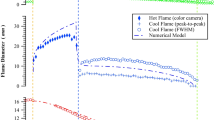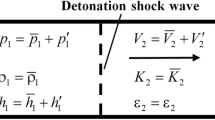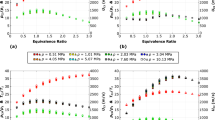Abstract
To understand the transient behavior of droplets after impingement in a diesel engine, a numerical model for diesel sprays impinging on a flat wall is newly developed by the proposition of several mathematical formulae to determine the post-impingement characteristics of droplets. The new model consists of three representative regimes such as rebound, deposition and splash. The gas phase is modeled in terms of the Eulerian conservation equations, and the dispersed phase is calculated using a discrete droplet model. To validate the new model, the calculated results are compared with several experimental data. The results show that the new model is generally in good agreement with the experimental data. Therefore, it is thought that the new model is acceptable for the prediction of transient behavior of wall sprays.
Similar content being viewed by others
Abbreviations
- D :
-
Droplet diameter
- d sp :
-
Diameter of the spread film disc
- m :
-
Droplet mass
- N :
-
Number of droplets in a parcel
- Oh :
-
Ohnesorge number
- Re :
-
Reynolds number
- ug, vg, wg:
-
Velocity component of the gas phase
- u′g, v′g, w′g:
-
Fluctuating velocity component of the gas phase
- ud, vd, wd:
-
Velocity component of the dispersed phase
- V :
-
Total velocity of droplet or control volume
- vt, vn:
-
Tangential and normal components of droplet velocity, respectively
- We T :
-
Weber number based on the total droplet velocity
- We n :
-
Weber number based on the normal droplet velocity
- Φ i :
-
Incident angle of impinging droplets measured from the wall
- θ:
-
Void fraction
- μ:
-
Viscosity
- ρ:
-
Density of the gas phase
- σ:
-
Surface tension
- Φ:
-
Viscous dissipated energy of liquid film built on the wall
- Ψ:
-
Time fraction at which the splash occurs
- ∀ f :
-
Volume of the film disc
- a, b :
-
After and before impingement, respectively
- d :
-
Droplet
- f :
-
Film
- rel:
-
Relative
- w :
-
Wall surfaces
References
Arcoumanis C. and Chang, J. C., 1994, “Flow and Heat Transfer Characteristics of Impinging Transient Diesel Sprays,”SAE940678.
Bai, C and Gosman, A. D., 1995, “Development of Methodology for Spray Impingement Simulation,”SAE950283.
Eckhause, J. E. and Reitz, R. D., 1995, “Modeling Heat Transfer to Impinging Fuel Sprays in Direct-Injection Engines,”Atomization and Sprays, Vol. 5, pp. 213–242.
Fujimoto, H., Senda, J., Nagae, M., Hashimoto, A., Saito, M. and Katsura, N., 1990, “Characteristics of a Diesel Spray Impinging on a Flat Wall,”COMODIA 90 Proceedings of International Symposium on Diagnostics and Modeling of Combustion in Internal Combustion Engines, pp. 193–198, Kyoto, Japan.
Gonzalez, M. A., Borman, G. L. and Reitz, R. D., 1991, “A Study of Diesel Cold Starting Using Both Cycle Analysis and Multidimensional Calculations,”SAE910180.
Guerrassi, N. and Champoussin, J. C., 1996, “Experimental Study and Modeling of Diesel Spray/Wall Impingement,”SAE960864.
Katsura, N., Saito, M., Senda, J. and Fujimoto, H., 1989, “Characteristics of a Diesel Spray Impinging on a Flat Wall,”SAE890264.
Kolpakov, A. V., Romanov, K. V. and Titova, E. I., 1985, “Calculation of the Rebound Condition for Colliding Drops of Sharply Different Sizes,”Kolloidn. Zh., Vol. 47, p. 953.
Lee, S. H., Ryou, H. S., and Chae, S., 1999, “Development of a New Spray/Wall Interaction Model,”2nd International Symposium on Two-Phase Flow Modeling and Experimentation, Vol. 3, pp. 1915–1999, Pisa, Italy, 23–26.
Matsumoto, S. and Saito, S., 1970, “On the Mechanism of Suspension of Particles in Horizontal Conveying: Monte Carlo Simulation Based on the Irregular Bouncing Model,”J. Chem. Engng. Japan, Vol. 3, pp. 83–92.
Mundo, C., Sommerfeld, M. and Tropea, C., 1995, “Droplet-Wall Collisions: Experimental Studies of the Deformation and Breakup Process,”Int. J. Multiphase Flow, Vol. 21, pp. 151–173.
Mundo, C, Sommerfeld, M. and Tropea, C., 1998, “On the Modeling of Liquid Sprays Impinging on Surfaces,”Atomization and Sprays, Vol. 8, pp. 625–652.
Naber, J. D. and Farrell, P., 1993, “Hydrodynamics of Droplet Impingement on a Heated Surface,”SAE930919.
Naber, J. D. and Reitz, R. D., 1988, “Modeling Engine Spray/Wall Impingement,”SAE880107.
O’Rourke, P. J., 1981,Collective Drop Effects on Vaporizing Liquid Sprays, Ph. D Thesis of Princeton Univ.
Park, K., 1994,Development of a Non-Orthogonal-Grid Computer Code for the Optimization of Direct-Injection Diesel Engine Combustion Chamber Shapes, Ph. D. Thesis, UMIST, UK.
Reitz, R. D., 1987, “Modeling Atomization Processes in High-Pressure Vaporizing Sprays,”Atomization and Spray Technology, Vol. 3, pp. 309–337.
Reitz, R. D. and Diwakar, R., 1987, “Structure of High-Pressure Fuel Sprays,”SAE870598.
Reynolds, W. C., 1980,Modeling of Fluid Motions in Engines—an Introductory Overview, inCombustion Modeling in Reciprocating Engines, ed. J. N. Mattavi and C. A. Amann, Plenum Press, NY.
Saito, A., Kawamura, K., Watanabe, S., Takahashi, T. and Tuzuki, N., 1993, “Analysis of Impinging Spray Characteristics under High-Pressure Fuel Injection (1st Report, Measurements of Impinging Spray Characteristics),”Trans. of Jap. Soc. Mech. Engg., Part. B, Vol. 59, pp. 3290–3295.
Senda, J., Kanda, T., Al-Roub, M., Farrell, P. V., Fukami, T. and Fujimoto, H., 1997, “Modeling Spray Impingement Considering Fuel Film Formation on the Wall,”SAE970047.
Stanton, D. W. and Rutland, C. J., 1996, “Modeling Fuel Film Formation and Wall Interaction in Diesel Engines,”SAE960628.
Watkins, A. P. and Wang, D. M., 1990, “A New Model for Diesel Spray Impaction on Walls and Comparison with Experiment,”COMODIA 90 Proceedings of International Symposium on Diagnostics and Modeling of Combustion in Internal Combustion Engines, pp. 243–248, Kyoto, Japan.
Wachters, L. H. J and Westerling, N. A. J., 1966, “The Heat Transfer From a Hot Wall to Impinging Water Drops in a Spherical State,”Chem. Eng. Sci., Vol. 21, pp. 1047–1056.
Yarin, A. L. and Weiss, D. A., 1995, “Impact of Drops on Solid Surfaces: Self-Similar Capillary Waves, and Splashing as a New Type of Kinematic Discontinuity,”J. Fluid Mech., Vol. 283, pp. 141–173.
Author information
Authors and Affiliations
Corresponding author
Rights and permissions
About this article
Cite this article
Lee, S.H., Ryou, H.S. Modeling of diesel spray impingement on a flat wall. KSME International Journal 14, 796–806 (2000). https://doi.org/10.1007/BF03184466
Received:
Revised:
Issue Date:
DOI: https://doi.org/10.1007/BF03184466




